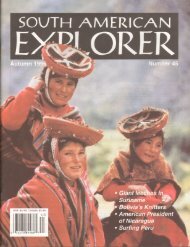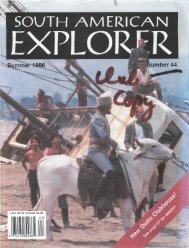Number 30 - South American Explorers
Number 30 - South American Explorers
Number 30 - South American Explorers
Create successful ePaper yourself
Turn your PDF publications into a flip-book with our unique Google optimized e-Paper software.
ful, listing 1,481 species divided into eightythree<br />
families and giving English, Spanish,<br />
and scientific names of each. Birding, with<br />
1,449 species listed (the discrepancy is because<br />
Galdpagos birds are omitted), lacks<br />
the niceties of the Spanish names and family<br />
divisions, but makes up for that by providing<br />
a useful bibliography and giving the sort of<br />
travel information that will be invaluable<br />
and, indeed, essential to anyone considering<br />
a private birding trip to Ecuador. Serious<br />
birders are advised to have both.<br />
—Rob Rachowiecki<br />
Kingdom of the Sun God<br />
A History of the Andes and Their People<br />
DAVID CAMERON<br />
$29.95 [Members $27.95] Item #177<br />
Kingdom of the Sun God is a solid, onevolume<br />
survey of the Andes Mountains and<br />
the peoples who have lived on them. Ian<br />
Cameron is the author of his own mountain<br />
of best-selling (21 million copies) travel and<br />
adventure books, including To the Farthest<br />
Ends of the Earth, a history of Royal Geographical<br />
Society expeditions. He kicks off<br />
his Andean tour with Darwin standing in the<br />
hills back of Valparafso, pondering "what<br />
forces had fashioned such a fine chaos of<br />
mountains." Over the years the explanations<br />
have included God's punishing us for our<br />
wickedness, a witch's plugging up volcanic<br />
vents, and pieces of Earth's crust colliding<br />
with each other. The plate tectonic theory<br />
was first proffered in 1915 by Alfred W.<br />
Wegener, a German scientist, but dismissed<br />
by geologists because he was a mere meteorologist.<br />
The weatherman was ri"ht.<br />
44 SOUTH AMERICAN EXPLORER<br />
Cameron shepherds the reader on a trek<br />
through several millennia of Andean history:<br />
the early civilizations, the Incas, the conquering<br />
Spanish, the first naturalists, the rebelling<br />
criollos, and the modern-day mountaineers,<br />
who have often been surprised to<br />
find that their virgin peaks were conquered<br />
long before by pre-Columbians. In 1953, for<br />
example, Henning Kristen led a team on a<br />
difficult climb to the top of the 19,455-foot<br />
Licancabur volcano in Chile, only to find the<br />
ruins of an Atacama Indian encampment.<br />
Kristen's reconquest of Licancabur is a reminder<br />
that these sierras have been homes,<br />
battlefields, laboratories, and gymnasia for<br />
thousands of years. —Daniel Buck<br />
Inca Civilization in Cuzco<br />
R. TOM ZUIDEMA<br />
$9.95 [Members $8.95] Item #166<br />
Inka Settlement Planning<br />
JOHN HYSLOP<br />
$<strong>30</strong>.00 [Members $28.00] Item #170<br />
At the Crossroads of the<br />
Earth and the Sky<br />
An Andean Cosmology<br />
GARY URTON<br />
University of Texas Press, $11.95 paper<br />
The University of Texas Press has recently<br />
published or reissued three studies<br />
which examine the organization of time and<br />
space in the Andean world.<br />
Although Hyslop's/nfaz Settlement Planning<br />
comes with all the scholarly accoutrements<br />
in the form of maps, notes, drawings,<br />
photographs, diagrams, glossary, and an extensive<br />
bibliography, the book is fairly easy<br />
going for the generalist. Hyslop efficiently<br />
introduces his reader to the principles of<br />
Inca architecture and settlement planning<br />
and then moves, chapter by chapter,<br />
through organizing elements like the physical<br />
relationship of manmade structures to<br />
natural features, types of settlements or patterns,<br />
environmental influences, and orientation<br />
and alignment. While the Cuzco area<br />
is central to the study, Hyslop has visited and<br />
cited sites representing the widest range of<br />
the Inca empire. This is a fairly readable text<br />
which encourages and supports a general<br />
reader who is undaunted by thoroughness.<br />
Anyone who has read Hyslop's earlier study,<br />
The Inka Road System, will find this a suitable<br />
companion volume.<br />
Inca Civilization in Cuzco is a series of<br />
lectures originally delivered in French at the<br />
College de France. The title is perhaps misleading<br />
in its disarming simplicity, as this is a<br />
study which assumes a familiarity with<br />
sources and theory. Additionally, the language,<br />
intended for an academic audience<br />
(and a translation, to boot), makes no concessions<br />
to the reader. For the generalist, no<br />
matter how sincere his interest, this is a demanding<br />
text. For the reader with a more<br />
than average background, however, this is a<br />
rewarding although rigorous read. R. Tom<br />
Zuidema is a structural anthropologist who<br />
has made important contributions to our<br />
understanding of the Andean world. He has<br />
attempted to discover the organizing principles<br />
of that world and to define a complex<br />
structure which is capable of explaining<br />
myth, ritual, kinship, and concepts of time<br />
and space. In this collection Zuidema treats<br />
history and myth, administration and kin<br />
models, and spatio-temporal organization.<br />
At the Crossroads of the Earth and the Sky<br />
examines the view of the universe in a contemporary<br />
Andean community. Urton, who<br />
trained with Zuidema, draws on<br />
ethnohistorical sources as well as several<br />
years of ethnographic fieldwork in the<br />
Maras-Misminary area outside Cuzco.<br />
Through observation and interview, Urton<br />
examines celestial bodies and configurations,<br />
the lore associated with them, their<br />
correlation to and effect on terrestrial functions,<br />
and their place in the organization of<br />
the universe, as viewed in this part of the<br />
Andean world. While Urton clearly is seeking<br />
to define underlying cognitive structures,<br />
his work is as concrete as it is theoretical.<br />
The narrative, while academically respectable,<br />
is an outstanding example of how good<br />
writing can engage the general reader and to<br />
lead him to higher levels of understanding<br />
and deepened interest.<br />
Taken together the three works cover<br />
the full spectrum of chronology, geographical<br />
extension, conceptual originality, and<br />
readability. Individually they make very distinct<br />
contributions and will appeal to very<br />
different readers. —Dorothy Joba





